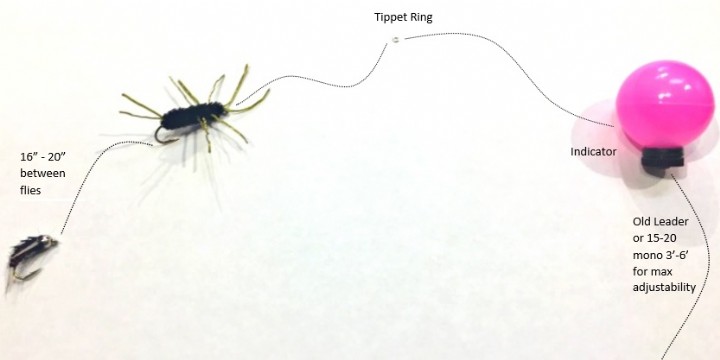Tippet Rings – Why and How to Use them:
In the past few years of working in a fly shop, it seems more and more customers are looking for tippet rings. So what exactly is a tippet ring and why should you use them?
A tippet ring is a very tiny circular ring that can save you time and money out on the water. The tippet ring can be incorporated into a fly fishing rig various different ways depending on depth, type of fishing, species you are targeting, and personal preference. The options are endless.
Here in Colorado, I use a tippet ring when I’m nymphing with an indicator. I typically will use 7.5 4x leader and will cut about 2-3 feet of the tippet off the leader and tie the tippet ring into the leader with a basic clinch knot. Then, I will take the tippet that I cut off the leader and tie a clinch knot onto the tippet ring. From here I will tie on my first fly and then tie a second on the back, just like your typical nymphing rig. (A lot of our guides will just use old leaders about 5 feet in length and tie a tippet ring onto this. Then from here, you can put anywhere between 3-6 feet of tippet onto the end.) I found that utilizing this relatively new piece of terminal tackle allows more productivity and convenience in my rig.

Advantages
Productivity:
This rigging technique allows for really good action for your flies. The flies will have more play because the tippet is thinner than a tapered leader. The flies will also drop into the water column faster. This is due to less resistance on the tippet opposed to a tapered leader. I also believe the tippet ring creates a better angle for the flies to drop into the water column. The flies drop at an angle that will put them perfectly into that feeding lane and often times gets rid of the loop that is formed when nymphing. In this way the tippet ring increases the productivity of the rig. Some anglers, specifically Euro-Nymphing specialists, use tippet rings to create connection points for droppers. This creates better angles for the nymphs, as they are tied off on tag ends.
Convenience:
Another benefit is how easily you can change out tippet sizes. Say you have your classic girdle bug leading your nymph rig and it has yet to produce. You want to put on the size 20 midge. You can change that 3x tippet and put on 6x without having to build out your leader and tie multiple double surgeons or blood knots to ensure knots are set. Ultimately instead of having a beat up leader, you can just keep using the same leader. Since you are just interchanging the tippet and not putting a bunch of knots in the leader. Which in the end will not only save you time of completely re-rigging but also save money on buying new leaders.
Less Versatile:
Some negative feedback I have had while using these tippet rings is when I only bring one rig with the tippet ring to the river and the fish start going crazy on the surface. I can’t easily change my nymphing rig with the tippet ring into a dry fly rig. You can still throw a dry fly with these tippet rings, but in my experience, the presentation is altered more than a regular tapered leader.
Depth Adjustment:
You should also be careful where exactly in the rig you set your tippet ring. Say the tippet ring is set 6 feet into the leader. You begin to fish a shallow run and want to adjust your indicator to 3 feet. This will cause the tippet ring to be on the wrong side. So think about the type of water you will be fishing when building your tippet ring into the leader.
Tippet rings have become an important piece of terminal tackle that only costs $6.95 for a pack of 10. It might seem a little weird as fly anglers to tie in a small piece of metal into your rig. But give it a shot and you will be impressed.





